Recently I paid a visit to the medieval pilgrim shrine of the holy statue of the Blessed Virgin of Monserrat in Spain.
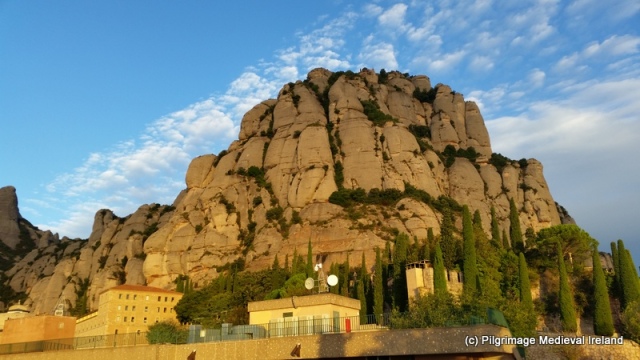
View of the monastery of Montserrat
The shrine is located at a Benedictine abbey at Montserrat, around 40 miles from Barcelona in the province of Catalonia. The abbey is a working monastery and home to 80 monks. The monastery is overshadowed by majestic mountains. The name Montserrat is derived from Catalan and means ” serrated mountain”. When you stand back and look at this jagged and rocky mountain you can see why the name was chosen.
Religious activity in the area can be traced back to early medieval times. It is said that a hermitage dedicated to the Blessed Virgin, was constructed here some time between the sixth-ninth centuries. According to legend the statue which is the focus of the pilgrimage was carved by St Luke and brought to Spain and hidden in cave at Monserrat. In the year 880 some shepherds were grazing sheep in the mountains when they saw a light and heard otherworldly singing. When the shepherds when to investigate they found the statue in a cave.
Following the discovery of a statue of the Blessed Virgin and Christ Child, the site gradually evolved and by the eleventh century abbot Oliba of the Monastery of Ripoll established a small monastery here beside the chapel of Santa María. A small Romanesque church was built beside the monastery and the image of the Virgin placed inside.
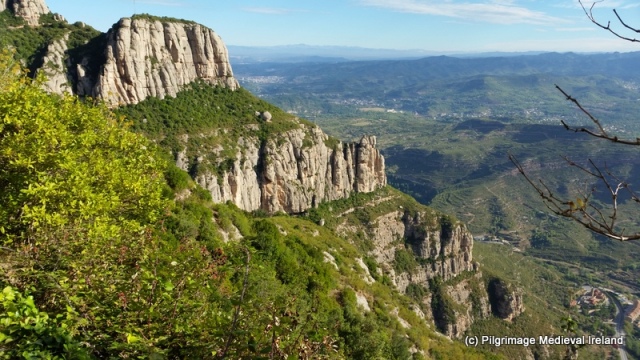
View of the valley below the monastery at Monserrat
My pilgrimage to Monserrat began in Barcelona when I boarded a coach at 6.45am. I arrived at the monastery at 8am. Monserrat is a very important tourist destination and attracts vast numbers of tourist each year so the site is always busy throughout the year. My early morning start meant that I and my fellow travelers were able to arrive just as the shrine opened and experience the place without the bustle of crowds, who arrived later in the morning.
The Vewpoint of the Apostles is the first monument that tourists who arrive by car or coach see. It is named after the Chapel of the Apostles which was demolished in the early twentieth century. It offers spectacular views of the valley below. It is located beside a piece of sculpture known as The Stairway to Understanding . The Stairway is a concrete monument 8.7m high created in 1976 by Josep Maria Subirachs. The sculpture consist of nine blocks placed one on top of the other that represent the different beings of creation from the more material to the most spiritual.
From this point you walk along an avenue known as Passeig de l’Escolania or the Choir Walk, passing the buildings where the which houses the choristers.
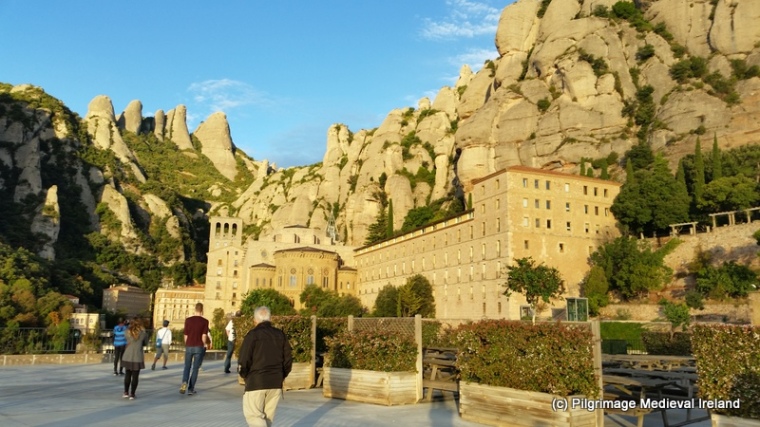
As you approaching of basilica of Montserrat you are at all times aware of the mountains that tower of the monastery.
The monastery also houses the Publicacions de l’Abadia de Montserrat, a publishing house that is the oldest printing press in the world, still in operation. Its first book was printed in 1499 and you can buy many of its modern publications in the monastery gift shop.
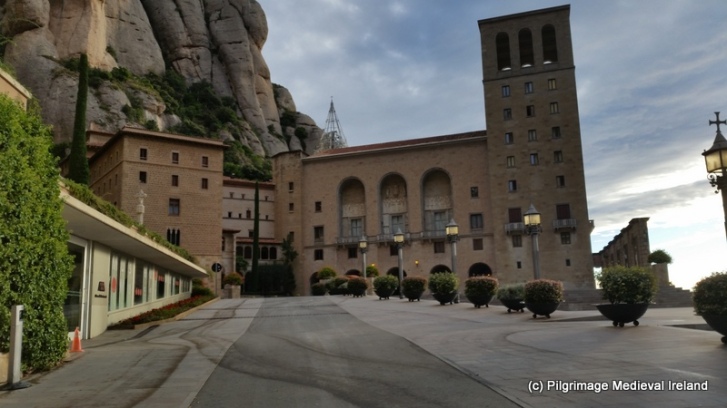
Approaching Plaça de la Crue (Square of the Cross)
As you approach the basilica and the Plaça de la Crue you pass by a wonderful sculpture of Saint George carved by Josep Maria Subirachs, an identical statue of the saint carved in a different darker type of stone is found in the La Sagrada Familia in Barcelona. St George along with Our Lady of Monserrat is a patron saint of Catalonia.
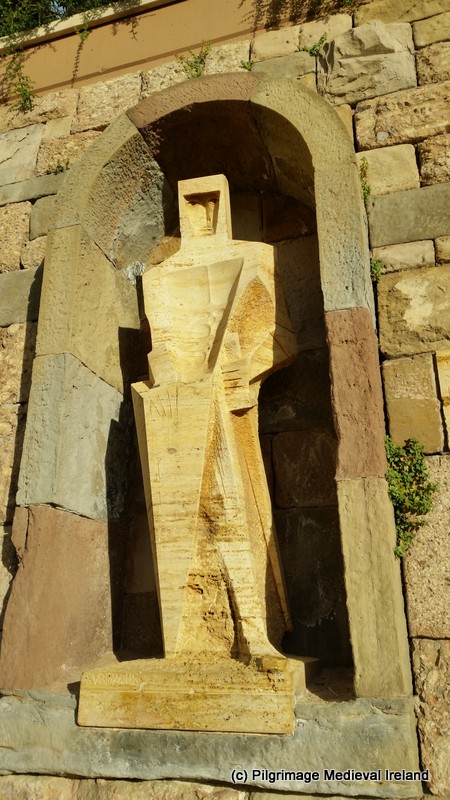
St George by Josep Subirach.
The monastery buildings are constructed from polished stones quarried from the mountain. When the sun shines on the stone it gives it a lovely warm golden colour which blends into the surrounding mountains. From the Plaça de la Crue you enter into the atrium in front of the basilica.
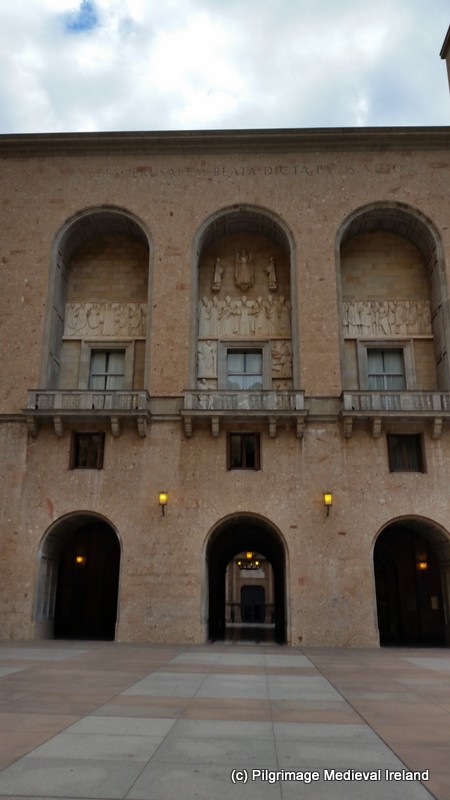
From the Plaça de la Crue you enter into the atrium
The atrium of the basilica is surrounded by buildings constructed in the eighteenth century. The mosaic floor is particularly impressive and was designed by Fr Benet Martinez (1918-1988).
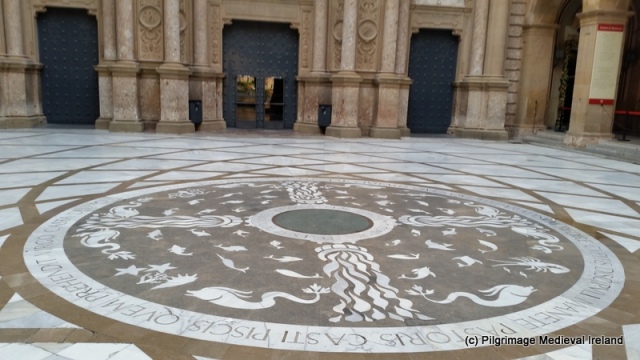
Mosaic floor in the atrium at Monserrat
The floor is a reproduction of a design by Michelangelo for the Campidoglio in Rome.
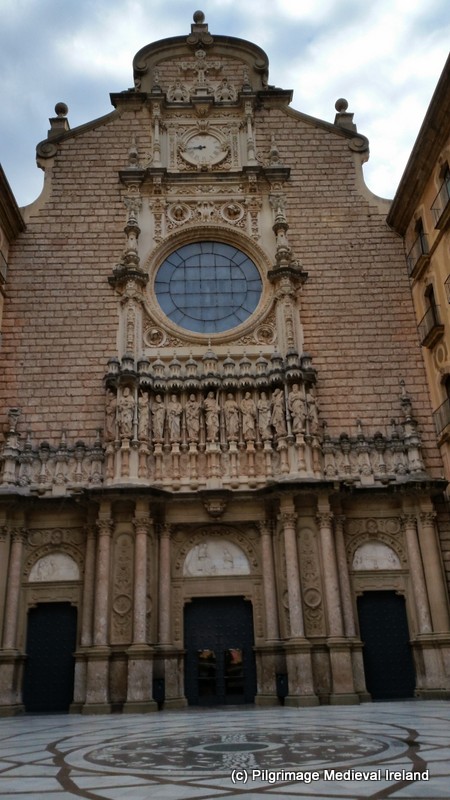
Facade of the bascilia at Monserrat
The current facade of the basilica was created in 1901, above the door are sculptures of Christ and the twelve apostles.
The statue of Our Lady of Monserrat is located in the basilica above the high altar.
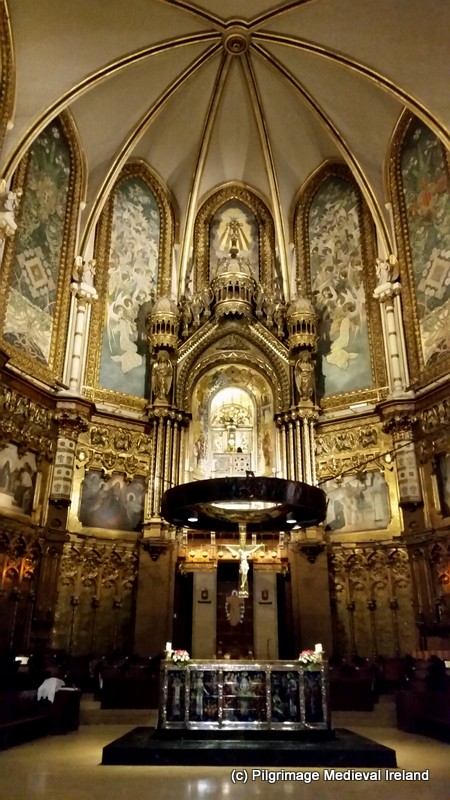
High altar within the basilica church.
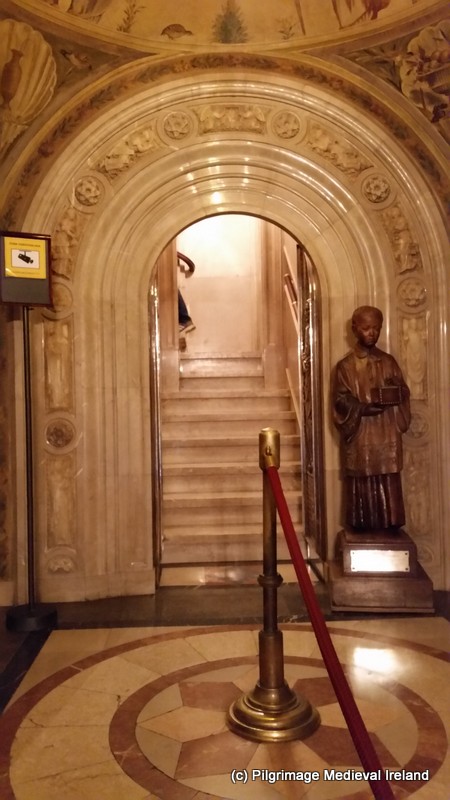
Stairs leading to the shrine of the statue of Our Lady of Monserrat.
The shrine is very elaborate and its walls are covered in gold mosaic and marble. The ceiling depicts the four archangels.
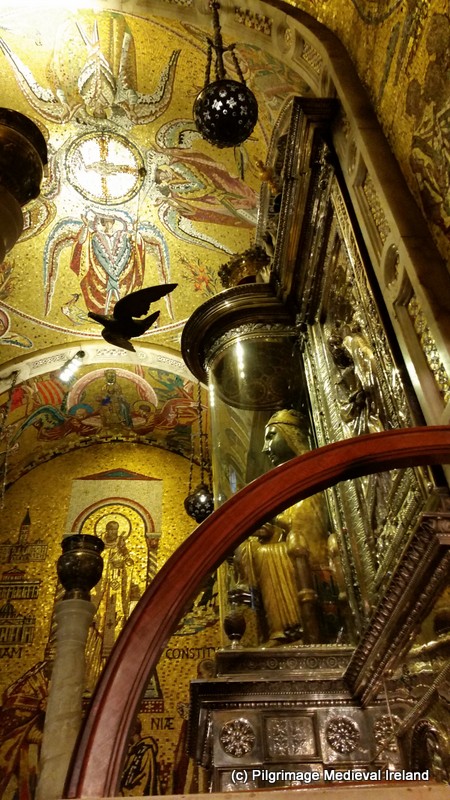
View statue from top of stairs
The statue of Our Lady of Monserrat is Romanesque, polychrome statue 95cm (38inch) in height. The statue depicts Our Lady in Majesty. Mary is in a seated position with the Christ Child seated on her lap. In her hand she holds a sphere which symbolized the universe. Her left hand is placed on the Christ Child’s shoulder and is symbolic of his omnipresence. The Christ Child holds a pineapple in his hand the symbol of eternal life, with his other hand he offers a blessing. The image is popularly known as La Moreneta (the Dark One), due to the dark colour of the Blessed Virgins skin, a result of age and centuries of candle smoke. Pope Leo XIII proclaimed Our Lady of Montserrat Patron Saint of Catalonia in 1881.


The statue in turn sits within a silver shrine. According to the Monserrat website
In 1947, the image was enthroned in a silver altarpiece, paid for by popular subscription and installed in the upper section of the basilica apse.
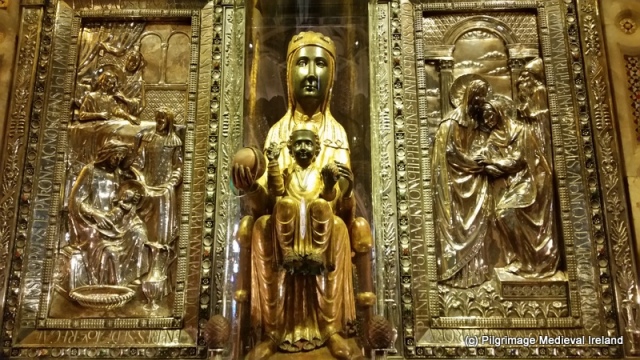
Our Lady of Monserat behing glass
Today the statue is protected behind glass. There is an opening for the globe held in Mary’s hand. This opening allows the globe to be accessible to devotees. Modern pilgrims will often touch, kiss, rub rosary beads and cloth against he globe it as they pray before the statue.
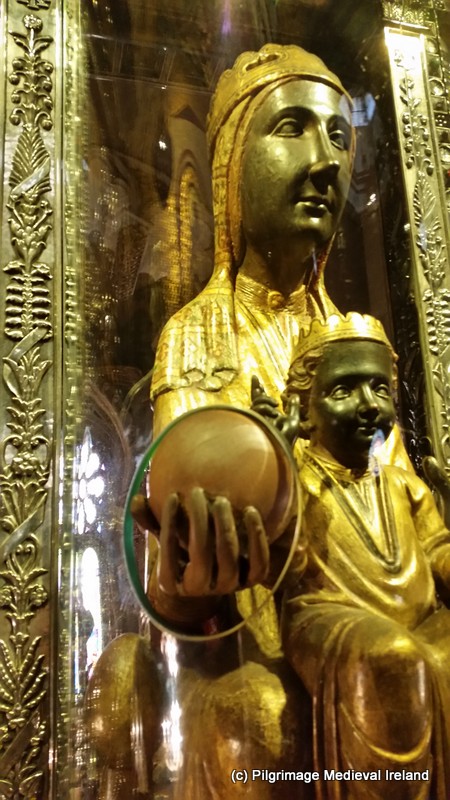
The statue of Our Lady of Monserrat holds a globe symbolizing the cosmos in her hand.
The statue looks out the basilica church. It must be quiet a sight to see the church full with pilgrims.
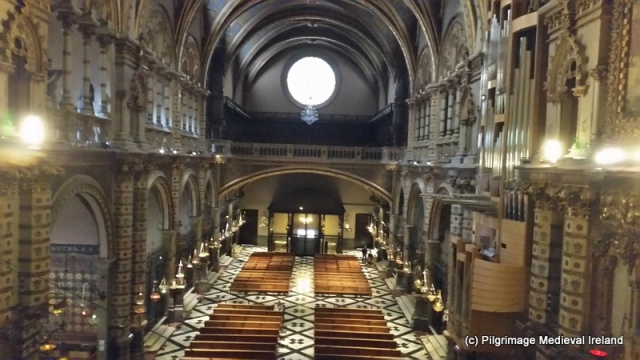
View of the basilica church from Shrine of the Lady of Monserrat from above the altar
Monserrat has been a pilgrim destination from at least the twelfth century when the current statue was created. Many miracles were recorded in medieval times and Alfonso X el Sabio in the thirteenth century recorded some in Cantiagas de Nuestra Señora (Talbot 2010, 454). Throughout the late medieval period the statues was visited by countless pilgrims including St Ignatius Loyola.
In recent centuries the shrine has had a more turbulent history. The monastery was sacked by Napoleon in the early nineteenth century destroying much of the medieval fabric luckily the statue survived after being hidden by the monks. In the twentieth century 23 custodian monks were shot during the Spanish Civil war. Today the site continues to attract pilgrims and it is also one of the most popular tourist destination in Catalonia.
The side chapels and the grounds of the monastery are filled with wonderful sculpture by Spanish artist. If you follow this link it will you can experience a virtual tour of Monserrat Cathedral and shrine.
Montserrat is also famous for the boy’s choir called L’Escolania who trace their history back to 1223 . The Boy’s Choir performs at least two times a day for most of the year at the Montserrat Basilica they also give concerts around the world . They specialize in a type of singing known as Gregorian chanting.
Useful Links & Sources
Virtual tour of Monserrat Bascilica http://www.montserratvisita.com/en/virtual
Esteve Serra i Pérez, 2016, Monserrat. Geocolor.
Talbot, L. 2010. ‘Monserrat’ In Taylor, L. et al. Enclyopedia of Medieval Pilgrimage. Boston: Brill p453-454.
http://comenius-legends.blogspot.ie/2010/07/la-morenetta-black-virgin-story.html
https://en.wikipedia.org/wiki/Virgin_of_Montserrat#Description
http://www.montserratvisita.com/en/spirituality/our-lady
http://www.csj.org.uk/planning-your-pilgrimage/routes-to-santiago/routes-in-spain/catalan-caminos/





